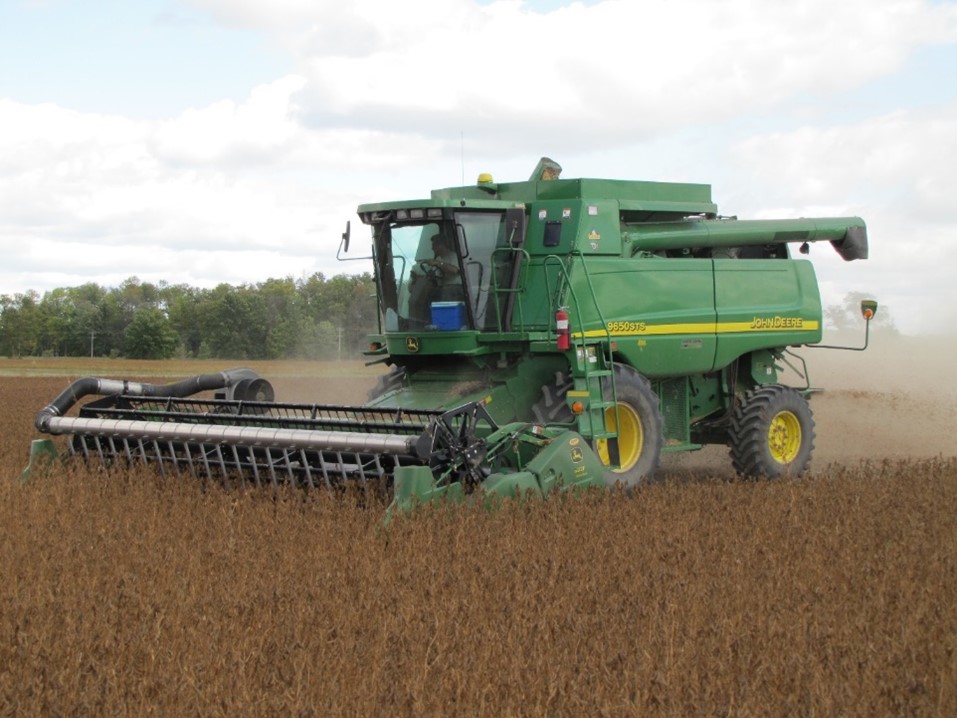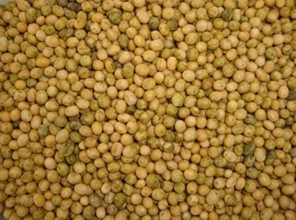Soybeans are direct combined, preferably with a combine equipped with a floating flexible cutter bar and automatic header height control. Although soybeans must be stored at a moisture level of 14% or less, they can be harvested when their moisture levels are less than 20%.
Harvest losses and mechanical damage may be high when soybeans are harvested below 11% moisture. A loss of just 43 beans/m2 (4 beans/ft2) represents an overall loss of 67 kg/ha (1 bu/acre). Maintaining a ground speed of 4-5 km/hr can minimize losses. The reel speed should be adjusted to match crop conditions.
A floater cutter bar cuts off the soybean plants close to ground level. To improve harvest, adjust:
- the cleaning fan to provide maximum air without blowing soybeans into the return elevator or out the back.
- the chaffer enables the fan to separate pods and stalk pieces from the seed.
- the sieve to allow only soybeans to pass through.
- the air speed, chaffer, and sieve throughout the day as the weather conditions and soybean moisture changes.
It is crucial to maintain the header. Most soybean losses occur at the header. To allow quick cutting action and rapid movement of the cut beans into the header, the cutter bar must be sharp, and the knife sections must make good contact with the guard ledger plates. An air real can get short beans into the feed auger quickly and reduce overall header losses, see figure 1.

Figure 1. Combine header equipped with an air reel to minimize seed losses.
If soybean plants remain standing and uncut behind the header:
- Inspect blades and guards.
- Consider reducing ground speed.
Pre-Harvest
If the soybean crop is intended for an identity-preserved (IP) market, make a special effort to maintain seed quality. Staining and mechanical damage are the main problems at harvest that can downgrade quality. An entire load may be rejected due to mechanical damage. Staining can occur from weeds, immature beans, dirt, and dust. To avoid contamination, make sure that combine, trucks, wagons, and bins are completely cleaned before harvest. Scout and rogue fields for off-types and other volunteer crops (e.g., corn). Inspect fencerows and roadsides for glass, metal, fence posts and other debris. To prevent green staining of the seed, IP bean harvesting must wait until all weeds and soybean stems have dried down completely. Remove weeds such as Eastern black nightshade and American pokeweed from the field before harvest, or have the operator avoid weed-infested areas. Figure 2 shows weed staining on harvested seed.

Figure 2. Soybean seed stained by green weeds at harvest.
Storage
When harvesting IP beans that are a different variety from the previous field harvested, thoroughly clean out the combine from top to bottom to remove trapped beans. An alternative, although less effective, method of combine cleaning involves combining a small area of IP beans separately and loading them into a “slush” wagon. The sample can be sold as non-IP soybeans and used to check moisture levels for combine and combine set-up. This method will not provide a 100% clean out.
Other harvest tips include:
- Keep a copy of the IP contract on hand to determine the quality parameters at harvest. IP harvesting starts later and ends sooner in the day compared to crush beans, primarily to avoid staining. Once contaminated, a combine is difficult to clean.
- It is best to harvest at moisture levels close to 14% to avoid the need for anything other than ambient air drying. To avoid cracked seed coats, harvest above 11% moisture, and handle gently.
- Throughout the day, adjust the combine to varying harvest conditions. Adjustments to reduce mechanical damage may increase dockage (pick) but are more than compensated for by premiums.
- Store IP soybeans in separate bins that are free of other soybean varieties and other grains.
If the crop was produced under contract, the signed agreement will contain an outline of all necessary requirements. Loss of premiums may occur from noncompliance with or without a contract.